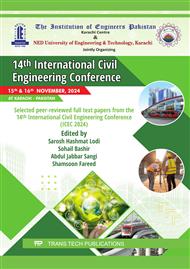[1]
Z. U. R. Farooqi, I. Ahmad, N. Zeeshan, P. Ilić, M. Imran, and M. F. Saeed, "Urban noise assessment and its nonauditory health effects on the residents of Chiniot and Jhang, Punjab, Pakistan," Environmental Science and Pollution Research, vol. 28, pp.54909-54921, 2021.
DOI: 10.1007/s11356-021-14340-4
Google Scholar
[2]
A. Gupta, A. Gupta, K. Jain, and S. Gupta, "Noise pollution and impact on children health," The Indian Journal of Pediatrics, vol. 85, no. 4, pp.300-306, 2018.
DOI: 10.1007/s12098-017-2579-7
Google Scholar
[3]
K.-T. Tsai, M.-D. Lin, and Y.-H. Chen, "Noise mapping in urban environments: A Taiwan study," Applied Acoustics, vol. 70, no. 7, pp.964-972, 2009.
DOI: 10.1016/j.apacoust.2008.11.001
Google Scholar
[4]
E. A. Papadimitriou, G. P. Papageorgiou, N. Alamanis, and T.-N. Diakosavva, "Road noise levels in urban environment compared to specification limits. The case of the City of Larissa, Greece," Periodica Polytechnica Civil Engineering, vol. 64, no. 4, pp.964-974, 2020.
DOI: 10.3311/ppci.14868
Google Scholar
[5]
A. Skånberg and E. Öhrström, "Adverse health effects in relation to urban residential soundscapes," Journal of Sound and Vibration, vol. 250, no. 1, pp.151-155, 2002.
DOI: 10.1006/jsvi.2001.3894
Google Scholar
[6]
G. Pandya, "Assessment of traffic noise and its impact on the community," International Journal of environmental studies, vol. 60, no. 6, pp.595-602, 2003.
DOI: 10.1080/0020723032000093973
Google Scholar
[7]
J. L. Morel, C. Chenu, and K. Lorenz, "Ecosystem services provided by soils of urban, industrial, traffic, mining, and military areas (SUITMAs)," Journal of soils and sediments, vol. 15, pp.1659-1666, 2015.
DOI: 10.1007/s11368-014-0926-0
Google Scholar
[8]
U. Gazder, M. R. Mehdi, F. Outay, and M. Arsalan, "Noise level based equivalency factors for different mobility options within heterogeneous traffic flow," Personal and Ubiquitous Computing, vol. 27, no. 5, pp.1681-1690, 2023.
DOI: 10.1007/s00779-023-01741-0
Google Scholar
[9]
R. R. Mato and T. Mufuruki, "Noise pollution associated with the operation of the Dar es Salaam International Airport," Transportation Research Part D: Transport and Environment, vol. 4, no. 2, pp.81-89, 1999.
DOI: 10.1016/s1361-9209(98)00024-8
Google Scholar
[10]
R. Bordoloi, A. Mote, P. P. Sarkar, and C. Mallikarjuna, "Quantification of land use diversity in the context of mixed land use," Procedia-Social and Behavioral Sciences, vol. 104, pp.563-572, 2013.
DOI: 10.1016/j.sbspro.2013.11.150
Google Scholar
[11]
M. R. Mehdi, M. H. Arsalan, U. Gazder, M. Kim, J. C. Seong, and S. I. Chang, "Who is the bigger culprit? Studying impacts of traffic and land use on noise levels in CBD area of Karachi, Pakistan," Environment, Development and Sustainability, vol. 20, pp.1421-1438, 2018.
DOI: 10.1007/s10668-017-9941-9
Google Scholar
[12]
S. Lautenbach, C. Kugel, A. Lausch, and R. Seppelt, "Analysis of historic changes in regional ecosystem service provisioning using land use data," Ecological indicators, vol. 11, no. 2, pp.676-687, 2011.
DOI: 10.1016/j.ecolind.2010.09.007
Google Scholar
[13]
W. Babisch, "Health aspects of extra-aural noise research," Noise and health, vol. 6, no. 22, p.69, 2004.
Google Scholar
[14]
D. V. Aparicio-Ramon, M. S.-V. MM, L. Ruano, and A. Sanchez, "Subjective annoyance caused by environmental noise," Journal of environmental pathology, toxicology and oncology: official organ of the International Society for Environmental Toxicology and Cancer, vol. 12, no. 4, pp.237-243, 1993.
Google Scholar
[15]
T. Münzel, M. Sørensen, and A. Daiber, "Transportation noise pollution and cardiovascular disease," Nature Reviews Cardiology, vol. 18, no. 9, pp.619-636, 2021.
DOI: 10.1038/s41569-021-00532-5
Google Scholar
[16]
C. Tonne et al., "Socioeconomic and ethnic inequalities in exposure to air and noise pollution in London," Environment international, vol. 115, pp.170-179, 2018.
DOI: 10.1016/j.envint.2018.03.023
Google Scholar
[17]
W. H. Organization, Burden of disease from environmental noise: Quantification of healthy life years lost in Europe. World Health Organization. Regional Office for Europe, 2011.
Google Scholar
[18]
R. T. Buxton et al., "Noise pollution is pervasive in US protected areas," Science, vol. 356, no. 6337, pp.531-533, 2017.
Google Scholar
[19]
T. Rehman, S. Panezai, and S. Ainuddin, "Drought perceptions and coping strategies of drought-prone rural households: a case study of Nushki District, Balochistan," Journal of Geography and Social Sciences (JGSS), vol. 1, no. 1, pp.44-56, 2019.
Google Scholar
[20]
M. Ashraf, "Farmers' coping and adaptive strategies towards drought in Pishin District, Balochistan," Journal of Geography and Social Sciences (JGSS), vol. 1, no. 1, pp.1-16, 2019.
Google Scholar
[21]
M. H. Bazai and S. Panezai, "Assessment of urban sprawl and land use change dynamics through GIS and remote sensing in Quetta, Balochistan, Pakistan," Journal of Geography and Social Sciences (JGSS), vol. 2, no. 1, pp.31-55, 2020.
Google Scholar
[22]
Z. Khan, Z. Khan, A. Ahmed, and M. H. Bazai, "Land use/land cover change detection and prediction using the CA-Markov model: A case study of Quetta city, Pakistan," Journal of Geography and Social Sciences (JGSS), vol. 2, no. 2, pp.164-182, 2020.
Google Scholar
[23]
S. NEELUM, S. PANEZAI, and S. E. SAQIB, "EXPLORING CAUSES, EFFECTS AND POSSIBLE SOLUTIONS OF TRAFFIC CONGESTION IN PAKISTAN: THE CASE OF QUETTA METROPOLITAN CITY."
Google Scholar
[24]
H. C. Manual, "HCM2d10," Transportation Research Board, National Research Council, Washington, DC. https://www. sciencedirect. com/topics/engineering/highway-capacity-manual, 2010.
Google Scholar
[25]
A. Jagniatinskis, B. Fiks, O. Zaporozhets, and M. Mickaitis, "Annual assessment of noise generated by road traffic using measurements," Procedia Engineering, vol. 187, pp.614-619, 2017.
DOI: 10.1016/j.proeng.2017.04.421
Google Scholar
[26]
F. Bunn and P. H. T. Zannin, "Urban planning-Simulation of noise control measures," Noise Control Engineering Journal, vol. 63, no. 1, pp.1-10, 2015.
DOI: 10.3397/1/376301
Google Scholar
[27]
(2012). Balochistan Environmental Protection Act 2012. Available: https://bepa.gob.pk/balochistan-environmental-protection-act-2012/
Google Scholar


